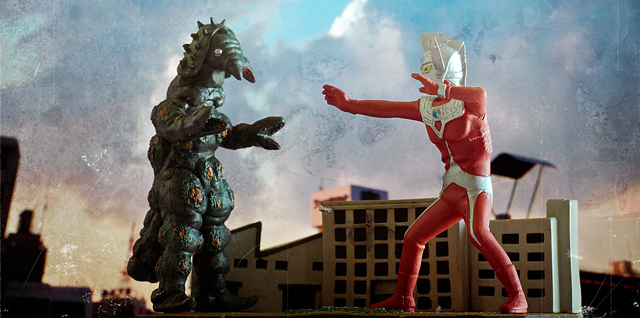
当奥特曼系列于1966年首次于日本上映时, 尽管表演劣质,故事情节老套,就是一个人穿着弹力服和看起来很假的怪兽打架,但依然大获成功。这个系列为孩子们创造了一个想象的空间,让他们能够幻想成为超级英雄,甚至是某一个强大的怪兽。
July 7 marks the 50th anniversary of the series’ creation. But it’s not just Ultraman rekindling fans’ *nostalgia. Other kaijus are making a comeback too.
7月7日是这个系列诞生五十周年的纪念日。但不仅仅是奥特曼粉丝们重燃怀旧情结,也让其他的怪兽回归人们的视野。
There has long been a fascination with kaijus in Japanese culture. There isn’t even an equivalent word in English for kaiju. The word “monster” can refer to anything that is inhuman, including the bloodthirsty *extraterrestrials in Alien and the highly intelligent great white shark in Jaws. Yet none of these characters would be considered a kaiju.
在日本文化中,怪兽 (Kanju) 一直有种魅力。在英文里,找不到一个和日文“Kaiju”完全对应的词。”Monster”一词可以指任何非人的生物,包括在《异形》中嗜血的外星人以及在《大白鲨》中十分聪明的大白鲨。但是这些角色都不能被看做是日文里的怪兽。
No matter what form it takes, a kaiju is best identified by its size: These creatures are large enough to destroy entire cities.
无论以什么样的形式出现,怪兽的体型都是它的最重要特征:这些生物庞大到足以毁灭整个城市。
One possible explanation for the kaiju *craze is that these super-sized monsters give Japan a way of fictionalizing its history with natural disasters. Earthquakes, volcanoes, *tsunamis and typhoons have not only affected Japan’s environment but also the mentality of its people. As a result, the kaijus that appear in literature and pop culture are seen as “a mythic *personification of natural destructive forces”, American writer Patrick Macias told the BBC.
对于怪兽的狂热,可能的解释是这些庞然大物让日本自然灾害频发的历史故事化。火山、地震、海啸以及台风不仅仅影响着日本的自然环境,也影响着人们的心理状态。因此,在文学和流行文化中出现的怪兽形象被视为“一种神话般的大自然毁灭性力量的象征”,美国作家帕特里克•马西亚告诉英国广播公司。
Just look at Godzilla, one of the most classic kaiju characters in Japanese culture. “He’s a dragon-cum-dinosaur after all, not a human being or even a creature with recognizable emotions [like] King Kong,” said Macias. “So there’s a spark of the *divine there, the ‘God’ in Godzilla, if you will; indifferent to the ant-like humans that inhabit this planet, [he] can easily become *wrathful or a bringer of death.”
只要看看日本文化中最经典的怪兽角色之一哥斯拉就知道了。“归根结底,他是龙和恐龙的结合体,不是人类或是像金刚那样有着可辨识情绪的生物,”马西亚说道。“所以有种神圣感,是存在于哥斯拉体内的‘上帝’,如果你愿意这样说的话;他对于居住在这个星球上,宛如蝼蚁般的人类冷漠无情,并且很容易暴怒,所到之处死亡遍布。”
Kaiju *lore also draws from a national trauma unique to Japan: It is the only country on Earth to have experienced atomic bombing. Considering that the first Godzilla film was released back in 1954, when the nuclear bombings of Hiroshima and Nagasaki were still fresh in the Japanese consciousness, many people see Godzilla as a symbol of nuclear weapons. This mindset was proved to be still very much alive after the 2011 Fukushima nuclear power plant accident.
怪兽的传说也源自于日本独有的一场国难:它是地球上唯一一个曾遭受过原子弹袭击的国家。当1954年首部哥斯拉电影上映时,日本民众对于广岛、长崎原子弹爆炸还有着鲜明的印象,很多人将其视为核武器的一种象征。在2011年福岛核电站事件后,这种心态被证实依然十分鲜活。
“In the days immediately after the Fukushima disaster in 2011, Google hits on Godzilla *spiked,” William Tsutsui, an American historian and Japan expert, told The Telegraph. “People went back to look at the movies, and look at the lessons filmmakers had been bringing forward
“在紧接着2011年福岛灾难后的日子里,哥斯拉在谷歌网站上的点击率激增,”美国历史学家以及日本专家,威廉•筒井,向《电讯报》说道。“人们回头来看这些电影,来看电影制片人所提出的,关于不加控制的核能及核武器试验的教训。”
查看更多关于【美文阅读】的文章



















